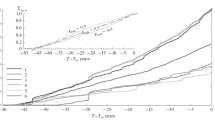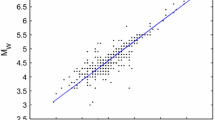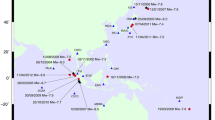Abstract
Double earthquakes are strong earthquakes close in time, place, and magnitude. They are quite rare and hard-to-explain events. It is important to clarify the nature of their occurrence for earthquake forecasting. The method of seismic entropy, involving the results of studying the processes in the sources of strong earthquakes, allows one to identify the nature of such earthquakes, to recognize them as independent earthquakes with a specific tectonic relationship, to distinguish them from other cases of close but independent earthquakes, as well as to identify them against the background of foreshocks and aftershocks. Double earthquakes are found in the seismic systems located in the different seismotectonic situations in Altai, the Kuril Islands, and the central United States, but Pakistan should be acknowledged as their “homeland.” Characteristic features which were used to classify these earthquakes are studied.













Similar content being viewed by others
REFERENCES
Akopian, S.Ts., Quantitative description of seismic processes based on seismic entropy, Izv., Phys. Solid Earth, 1998, vol. 34, no. 1, pp. 8–22.
Akopian, S.Ts., Quantitative Description of Seismic Processes in Real Medium and the Algorithm of Long-Term Prediction of Large Earthquakes: By Examples of the Armenian Upland, North-Western Iran, Italy and Central California, Moscow: Triumph Publishing, 2013.
Akopian, S.Ts., Seismic systems of Japan: Entropy and monitoring of the Tohoku earthquake, March 11, 2011, Seism. Instrum., 2014, vol. 50, no. 4, pp. 347–368. https://doi.org/10.3103/S0747923914040021
Akopian, S.Ts., Open dissipative seismic systems and ensembles of strong earthquakes: Energy balance and entropy funnels, Geophys. J. Int., 2015, vol. 201, pp. 1618–1641. https://doi.org/10.1093/gji/ggv096
Akopian, S.Ts., Seismic systems, entropy production law, and ensembles of strong earthquakes, Izv., Phys. Solid Earth, 2016, vol. 52, no. 6, pp. 844–865.
Akopian, S.Ts., Entropy seismology and the view of cosmology: Seismic formalism and alphabet of evolution, Electron. J. Nat. Sci., 2017, vol. 28, no. 1, pp. 53–73.
Akopian, S.Ts., Entropy, seismicity monitoring in the Armenian Highlands and dynamics of the Akhurian reservoir filling, Seism. Instrum., 2018, vol. 54, no. 1, pp. 113–120. https://doi.org/10.3103/S0747923918010024
Akopian, S.Ts. and Kocharian, A.N., Critical behaviour of seismic systems and dynamics in ensemble of strong earthquakes, Geophys. J. Int., 2014, vol. 196, pp. 580–599. https://doi.org/10.1093/gji/ggt398
Akopian, S.Ts. and Rogozhin, E.A., Modeling kinematics of the Tauro-Caucasus region and dynamics of strong (M ≥ 7.1) earthquake preparation, Seism. Instrum., 2015, vol. 50, no. 2, pp. 125–139.
Akopian, S.Ts., Bondur, V.G., and Rogozhin, E.A., Technology for monitoring and forecasting strong earthquakes in Russia with the use of the seismic entropy method, Izv., Phys. Solid Earth, 2017, vol. 53, no. 1, pp. 32–51.
Avouac, J.P., Ayoub, F., Wei, S., Ampuero, J.P., Meng, L., Leprince, S., Jolivet, R., Duputel, Z., and Helmberger, D., The 2013, Mw 7.7 Balochistan earthquake, energetic strike-slip reactivation of a thrust fault, Earth Planet. Sci. Lett., 2014, vol. 391, pp. 128–134. https://doi.org/10.1016/j.epsl.2014.01.036
Bakun, W.H. and Hopper, M.G., Magnitudes and locations of the 1811–1812 New Madrid, Missouri, and the 1886 Charleston, South Carolina, earthquakes, Bull. Seismol. Soc. Am., 2004, vol. 94, no. 1, pp. 64–75,
Calais, E., Vergnolle, M., San’kov, V., Lukhnev, A., Miroshnitchenko, A., Amarjargal, S., and Deverchere, J., GPS measurements of crustal deformation in the Baikal-Mongolia area (1994–2002): Implications for current kinematics of Asia, J. Geophys. Res.: Solid Earth, 2003, vol. 108, p. 2501. https://doi.org/10.1029/2002JB002373
Emanov, A.F., Emanov, A.A., Leskova, E.V., Seleznev, V.S., and Filina, A.G., The Tuva earthquake of December 27, 2011 and its aftershocks, Vestn. Otd. Nauk Zemle Ross. Akad. Nauk, 2012, vol. 4. https://doi.org/10.2205/2012NZ000112
Jolivet, R., Duputel, Z., Riel, B., Simons, M., Rivera, L., Minson, S.E., Zhang, H., Aivazis, M.A.G., Ayoub, F., Leprince, S., Samsonov, S., Motagh, M., and Fielding, E.J., The 2013 Mw 7.7 Balochistan earthquake: Seismic potential of an accretionary wedge, Bull. Seismol. Soc. Am., 2014, vol. 104, no. 2, pp. 1020–1030. https://doi.org/10.1785/0120130313
Martin, S.S. and Kakar, D.M., The 19 January 2011 Mw 7.2 Dalbandin earthquake, Balochistan, Bull. Seismol. Soc. Am., 2012, vol. 102, no. 4, pp. 1810–1819. https://doi.org/10.1785/0120110221
Ovsyuchenko, A.N., Rogozhin, E.A., Marakhanov, A.V., Kuzhuget, K.S., Butanaev, Yu.V., Lar’kov, A.S., and Novikov, S.S., The results of field seismogeological studies of the 2011–2012 Tuva earthquakes, Tuvinskie zemletryaseniya 2011–2012 gg.: Materialy Nauchnogo soveshchaniya po bazovomu proektu TuvIKOPR SO RAN VIII.78.1.4 “Napryazhennoe sostoyanie seismoopasnykh zon Tuvy: Otsenka seismicheskoi bezopasnosti na osnove seismologicheskikh issledovanii i dannykh seti seismicheskikh stantsii” (The 2011–2012 Tuva Earthquakes: Proceedings of the Scientific Meeting on the Basic Research Project of the Tuvan Institute for Integrated Use of Natural Resources, Siberian Branch of the Russian Academy of Sciences No. VIII.78.1.4 “Stress State of Seismoactive Zones of Tuva. Seismic Safety Assessment on the Basis of Seismological Studies and the Data Obtained by Seismic Network,” Kyzyl, Russia, 2014), Kyzyl: TuvIKOPR SO RAN, 2014, pp. 57–78.
Ovsyuchenko, A.N., Rogozhin, E.A., Marakhanov, A.V., Lar’kov, A.S., Novikov, S.S., Kuzhuget, K.S., and Butanaev, Yu.V., Geological studies of the 2011–2012 Tuva earthquakes, Vopr. Inzh. Seismol., 2016a, vol. 43, no. 1, pp. 5–28.
Ovsyuchenko, A.N., Vakarchuk, R.N., Rogozhin, E.A., Butanaev, Yu.V., Marakhanov, A.V., Lar’kov, A.S., and Novikov, S.S., Tectonic position, geological manifestations, and tectonophysical implications of the 2011–2012 Tuva earthquakes, Chetvertaya tektonofizicheskaya konferentsiya v IFZ RAN: Tektonofizika i aktual’nye voprosy Nauk o Zemle (Tectonophysics and Topical Problems of the Earth Sciences: Fourth Tectonophysical Conference at the Institute of Physics of the Earth, Russian Academy of Science, Moscow, Russia, 2016), Moscow: Inst. Fiz. Zemli. Ross. Akad. Nauk, 2016b, pp. 502–506.
Rogozhin, E.A., Ovsyuchenko, A.N., Marakhanov, A.V., Larkov, A.S., and Novikov, S.S., Tectonic position and preliminary data on geological manifestations of the 2011–2012 Tyva earthquakes, Seism. Instrum., 2013, vol. 49, no. 2, pp. 178–187.
Timofeev, V.Yu., Ardyukov, D.G., Timofeev, A.V., Boiko, E.V., and Lunev, B.V., Block displacement fields in the Altai-Sayan region and effective rheologic parameters of the Earth’s crust, Russ. Geol. Geophys., 2014, vol. 55, no. 3, pp. 376–389.
Tuttle, M.P., Schweig, E.S., Sims, J.D., Lafferty, R.H., Wolf, L.W., and Haynes, M.L., The earthquake potential of the New Madrid seismic zone, Bull. Seismol. Soc. Am., 2002, vol. 92. P. 2080–2089.
Wesnousky, S.G., Predicting the endpoints of earthquake ruptures, Nature, 2006, vol. 444, no. 7117, pp. 358–360.
Author information
Authors and Affiliations
Corresponding author
Additional information
Translated by L. Mukhortova
About this article
Cite this article
Akopian, S.T. Double Earthquakes, Their Nature, and Forecast by the Method of Seismic Entropy. Seism. Instr. 55, 196–208 (2019). https://doi.org/10.3103/S0747923919020026
Published:
Issue Date:
DOI: https://doi.org/10.3103/S0747923919020026




